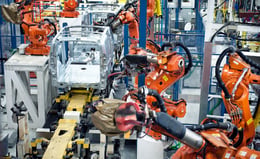5 Key Elements of Industry 4.0
Nick Ostdick - April 20, 2017

So much in the discussion of modern manufacturing surrounds the subject of Industry 4.0 and its influence on the daily, weekly, monthly, and even annual processes associated with the global manufacturing industry. In fact, one could argue the term Industry 4.0 is tossed around by industry insiders without truly understanding its place in the context of manufacturing and supply chain processes on a global stage.
Whether it’s misinformation about how Industry 4.0 came to be or the ways in which manufacturing companies can deploy the concept of Industry 4.0 as a core driver of moderneized, intelligent production, there’s still much supply chain planners and managers can learn about Industry 4.0 and its applications in today’s global manufacturing and supply streams.
For example, how does Industry 4.0 push the manufacturing industry to grow and evolve in terms of communication, technology, and planning and production processes? How can Industry 4.0 help companies actually achieve greater levels of operational efficiency and more accurate demand and planning forecasts? Why should manufacturing companies regard Industry 4.0 as a necessity rather than an industry buzzword or fad?
With these questions in mind, let’s examine 5 key elements of Industry 4.0 to better understand its place and overall value proposition in a global manufacturing stream.
Greater levels of product customization
Commonly referred to as 3D printing, additive manufacturing is the process of building an object by depositing material in multiple layers. The use of additive manufacturing has certainly become trendy, but it has yet to reach its full potential. Industry 4.0 provides the technological infrastructure for manufacturing enterprises to use 3D technology at scale, producing smaller numbers of more customized products. Because additive technology can be deployed on demand, production time for customized products is significantly reduced, resulting in shorter overall lead times and more accurate delivery timetables.
An important hallmark of an Industry 4.0 enterprise, is the robust integration of additive manufacturing throughout the supply chain, not only to produce quality, individually-tailored products for end users, but also for the manufacturing of customized machine parts within the supply chain itself.
Integration of Advanced Analytics
Nearly all supply chain planners and managers rely on analytics to inform and optimize production. As such, the implementation of advanced analytics consistently yields higher production quality, along with reduced downtime and improved customer experience — all contributing to a more specific, achievable bottom line. But these analytics are often disjointed or disparate, existing without a cohesive connection to an overarching structure or system of analysis and review. As the manufacturing world continues to evolve toward Industry 4.0, analytics systems are simultaneously evolving. The Industry 4.0 supply chain uses advanced analytics and Big Data to inform end-to-end (E2E) visibility. Up-to-the-minute data are available to support real-time decision-making and bring visibility to the entire supply chain, both within and without individual organizations.
This not only results in a supply chain capable of greater responsiveness to disruption, but is also means manufacturing companies can gain greater insight into their overall supply situation.
Pushing beyond postmodern ERP
The postmodern ERP mindset has just begun to catch hold in the supply chain and manufacturing industry, yet Industry 4.0 pushes the boundaries of this cutting-edge approach even further. Industry 4.0 calls for a truly agile supply chain that integrates IT systems both vertically and horizontally. Using robust data-integration networks that span usually-disconnected departments like engineering and customer services, the Industry 4.0 company is much more cohesive and able to transcend communication and planning silos in a cross-organizational manner. And because these data systems can communicate beyond the boundaries of the company, they provide unprecedented integration, resulting in a much more agile supply chain.
Embracing the Internet of Things
Another facet of holistic integration as part of Industry 4.0 is the incorporation of networked machines and sensors throughout the supply chain. The Internet of Things (IoT) refers to computing technology embedded in devices, which can communicate with other devices and people through the internet. Currently IoT is most often found vertically within an organization; for instance, the supply chain's devices and sensors communicate with each other, providing useful but limited intelligence to the manufacturing control system. The next phase, however, incorporates the IoT to communicate across departments as well. The Industry 4.0 supply chain fully leverages the IoT for streamlined, agile operations with far greater visibility and transparency.
Increased reliance (and positive outcomes) on cloud technology
The Industry 4.0 supply chain is a data-generation machine. It's constantly producing insights in real time, requiring incredible speed and precision, not to mention the capacity for instant access and E2E visibility. Those demands are best met in the Cloud. As Cloud technology continues to improve, the Industry 4.0 enterprise will increasingly deploy it for data management and functionality. Coupled with seemingly endless storage capacity and an ever-shortening reaction time, the Cloud offers the necessary agility for the supply chain of the next generation.
Cloud technology, with its centralized data inputs and sources, allows for increased communication and collaboration across a number of critical stages: procurement, planning, production, and transportation. Gone are the days when these actions operated independently of each other. Cloud technology via Industry 4.0 has pushed the industry into a new idea of connectivity where each process across the value chain impacts how a product moves from the production floor to the customer’s front door.
If you want to learn more get your Guide to Industry 4.0:
LATEST POSTS
- Understand Why Production Planning Needs Specialized Solutions
- Understand Circular Economy in The Manufacturing Industry
- How Can Industry 4.0 IT Integration Be Achieved Smoothly?
- The Significance of Order Sequencing in Discrete Manufacturing
- How to improve your Supply Chain Management: The Power of Control Towers



